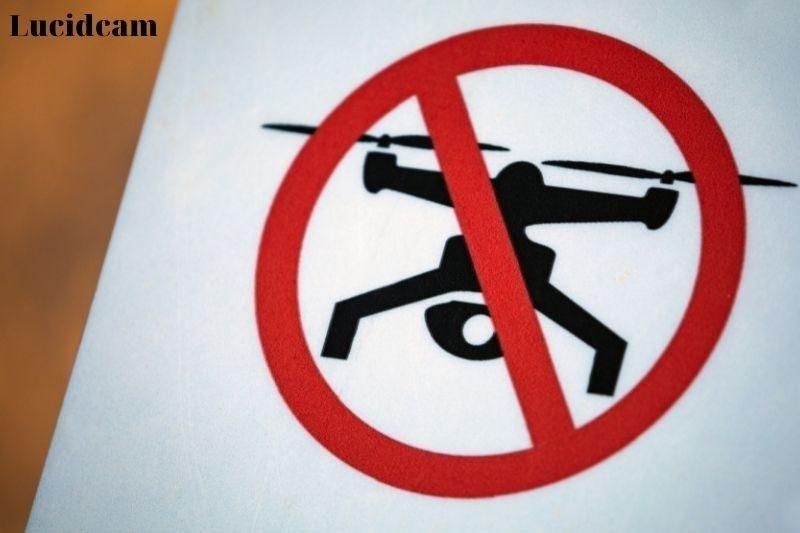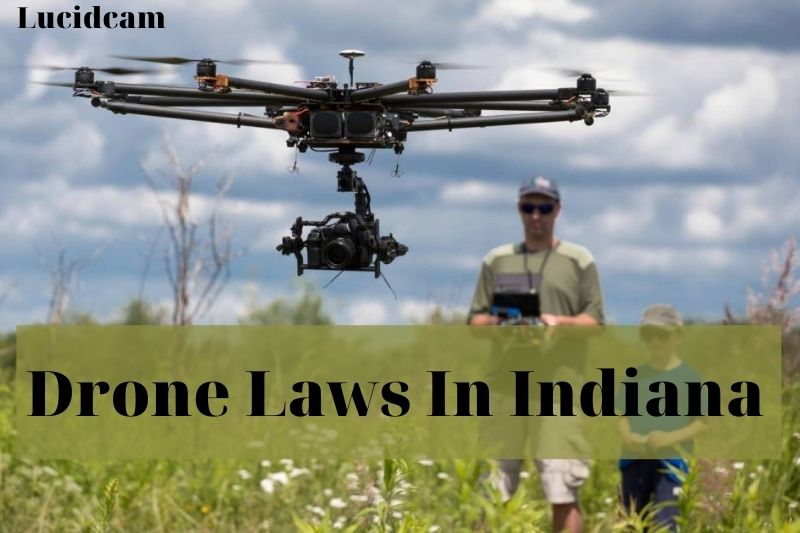- HanJin
Drones are becoming more popular for production in the United States. Drone rules are always changing. If you want to operate a drone in Indiana, you must be conversant with the Drone Laws.
This information will assist you in comprehending Indiana’s drone legislation. Let’s get explore Drone Laws Indiana
Table of Contents
Local Drone Laws in Indiana

These drone laws are specific to Indiana’s cities and regions. They were developed by different authorities.
Fort Wayne City Ordinance (SS 96.30) Regulation of Unmanned Aircraft Systems // 2019
The ordinance requires UAS operators to notify their city before flying above the Downtown Aerial District, within a radius of five hundred yards, or above, any public event. Notification must contain:
- Name, address, and telephone number for UAS operator. Any assisting persons during flight. (2) Affiliated company name, if applicable.
- The UAS can be used for noncommercial recreational or commercial purposes.
- FAA-issued Registration Number(s), for any UAS to operate;
- UAS operator’s FAA-issued Remote Pilot Certificate Number(s), and date(s), if applicable.
- Dates of expiration and document numbers for FAA-issued certificates, waivers, authorizations, or Section 333 exemptions, applicable to the operation of the UAS.
- Information about the policy, including dates of issue and expiry for any certificates of liability insurance.
- Area and time proposed for UAS operation
- The location from which the UAS will operate;
- Name, address, and telephone number of all owners who have granted permission for UAS operation in private spaces.
Federal Drone Laws In Indiana

These drone laws, which apply to all states in the U.S. including Indiana, were created by the federal government.
In Indiana, you can fly a drone commercially as a pilot. For work/business purposes, you must follow the FAA’s Part 107 Small UAS Rule. Part 107 includes passing the FAA Aeronautical Knowledge Test in order to receive a Remote Pilot Certificate.
In Indiana, drone flying is permitted as a hobby. The FAA requires you to pass the Recreational UAS Safety Test. The FAA also requires you to adhere to the rules for recreational model aircraft. You will need to pay $5 to register a drone if it weighs in at more than 0.55 lbs (250g). Additional rules apply to altitude and airspace, as well as keeping your drone in line of sight while you fly.
You can fly a drone in Indiana as a government employee (i.e. for a fire or police department), or you can operate under the Part 107 rule of the FAA.
Please note: This page is intended to be used as an informational tool and not as a substitute for legal advice.
Indiana Has State Drone Laws
These drone laws apply to Indiana and were established by the Indiana General Assembly.
According to the Indiana Department of Transportation, and the Indiana General Assembly there are five laws in Indiana that govern drone use.
SB 299 // 2017.
The law also creates new criminal offenses related to drone use.
A Sex offender who uses a UAV to contact, follow or record images or recordings of another person is called the “sex offense unmanned aerial vehicle crime”. The conditions prohibit them from using it.
This law applies only to sex offenders, as described in IC 11-8-8 4.5. The drone operator commits an offense when he or she knowingly or deliberately operates a UAV for any of the following:
- Follow one or more people in your mind
- Contact one or more people
- Without consent, deliberately capture images of one or several people
- Without consent, deliberately record audio/video of one or more people
A UAV operator who intends to interfere or obstruct a public safety official’s duties in the course of their duties is known as the “public safety remote aerial interference offense”.
This law creates class A misdemeanors for all offenses. If the guilty party has been convicted under the same section before, the offense becomes a level 6 crime.
Public safety remote air interference offense
This law occurs when a drone pilot knowingly or deliberately operates a UAV that interferes or obstructs a public safety official in his or her line of duty. These offenses are a class A misdemeanor unless there have been prior convictions under this section. This is a low-level 6 felony.
Indiana Statute Definition for Unmanned Aerial System
Indiana law defines Unmanned Aerial Vehicles (UAVs), as aircraft that can fly using a remote control or autonomous programming and doesn’t need a human operator.
HB 1013 // 2016.
This law permits drones to be used to photograph and take a video of a traffic crash site.
HB 1246 // 2016.
This law prohibits UAS use to scout game during hunting season.
IAC 312 8-2-8 i // 2018
This law prohibits drones from being used on property of the Indiana Department of Natural Resources (DNR), such as state parks, natural and recreational areas. DNR may grant licenses to launch or film occasionally.
Part 107 regulations apply to all drone pilots who operate commercially in Indiana. This guide provides information about how the FAA certifies drone pilots to obtain a commercial license.
House Bill HB 1009 (2014)
This law creates warrant requirements and exceptions for the police use of drones and real-time geo-location tracking devices. Indiana state law requires a law enforcement officer or agencies to obtain a warrant–with exceptions–to use drones in surveillance operations. It is a crime for UAV operators not to use private property for surveillance or photography. This law also creates the crime of “Unlawful Photography”. This becomes a Class A offense.
Indiana Code 35-33-5-9 – Unmanned aerial vehicles; search warrant; exceptions
Places limits on law enforcement use of drones; creates an exception that law enforcement may use drones to obtain aerial photographs or recordings of motor vehicle accidents on public streets or highways.
UAS Operation Rules in Parks, Recreation, and Cultural Preserves
IAC 312 8-2-8 I (i) (2018)
The 2018 law prohibits the operation of drones in state parks or recreational spaces. In certain circumstances, exceptions are allowed to launch drones or film from these areas. UAS operators need to apply for a Special License at Indiana’s Department of Natural Resources.
Notes For Recreational Drone Pilots Flying In Indiana

You can fly recreationally with a small drone weighing less than 55 pounds by following the FAA Part 107 Drone Laws.
Federal law approves recreational UAS operations in Indiana, specifically the FAA Part 107. For additional clearance, licensing or permissions, please check the state jurisdiction.
These rules will keep your drone and you safe, and help to keep airspace open for everyone.
- Only fly for recreation (enjoyment).
- Follow safety guidelines issued by an FAA-recognized Community Based Organization. Not yet, we have not officially begun to recognize CBOs. Recreational flyers should adhere to safety guidelines provided by existing aeromodelling organizations or follow the FAA’s safety guidelines per Advisory Circular 9-57B.
- You can keep your drone in the visual line of sight or you can use a colocated visual observer, which is physically next to you, and indirect communication.
- Crewed aircraft are not to be interfered with.
- With prior authorization using LAANC and DroneZone, fly at or below 400 feet in controlled airspace (Class C, D, E, and E).
- Fly below 400 feet in Class G (uncontrolled airspace). Not all drone flights are allowed in certain areas. You can search for navigable airspace and other classes of airspace by a drone pilot on the B4UFLY app, or on the UAS Facility Maps website.
- You must pass the Recreational UAS Safety Test.
- You must have a valid registration. Mark (PDF) your drones with the registration number and bring proof of registration.
- Your drone should not be operated in a dangerous manner. You can use this example:
- Do not interfere in emergency response or law enforcement activities.
- Flying under the influence of alcohol or drugs is not a good idea.
- Avoid flying close to or above critical infrastructure.
Recreational drone pilots need to be aware that they can be held responsible for violating any safety regulations and/or operating their drones recklessly or carelessly.
Notes On How To Operate Commercial Drone Services In Indiana

You can fly a small, unmanned aircraft less than 55 pounds to work or for business by following the Drone Laws of the USA as defined by FAA Part 107 guidelines.
The FAA Part 107 approves commercial drone operations in Indiana. For additional clearance, licensing or permissions, please check the state jurisdiction.
To fly under Part 107 rules, drone owners must take three steps:
Step 1: Read the Rules
- Part 107 rules are confusing. Make sure you know what is allowed and what isn’t. A summary of Part 107 rules can be found here (PDF). Are you unsure if Part 107 applies to your UAS operation? You can check the FAA user identification tool.
- Part 107 does not cover all operations and will require a waiver. These are just a few examples of Part 107 sections that are subject to waiver.
- Operation from a moving aircraft or vehicle (SS 107.25)
- Daylight operation (SS 107.29)
- Visual line of sight operation for aircraft (SS 107.31)
- Visual observer (SS 107.33)
- Multiple small unmanned aircraft systems operated (SS 107.35)
- Yielding the right-of-way (SS 107.37(a),)
- Operation over People (SS 107.39)
- Operation in certain airspaces (SS 107.41).
- Operating limits for small unmanned aircraft (SS107.51)
- *The FAA won’t waive this section to allow carriage of property by aircraft for compensation or hire.
- Read about the Part 107 waiver application process if your operation requires a waiver.
3. Commercial drone pilots should not fly near airports as it is difficult for manned aircraft see or avoid drones while flying. The UAS operator must keep clear of crewed aircraft. They are responsible for any safety hazards their drone causes in an airport environment. Learn more about flying close to airports.
Step 2: Pass the Knowledge Test to Become an FAA Certified Drone Pilot
- You must be at least:
- Minimum 16 years of age
- Ability to understand, read, write, and speak English
- To safely fly a UAS, you must be in good physical and mental health
2. Check out the complete process for obtaining your Remote Pilot Certificate or Drone License.
3. Review the FAA Test Prep Materials to help you prepare for the Knowledge Test.
4. Before you register for a knowledge exam, obtain an FAA Tracking Number.
5. Make an appointment to take the Knowledge Test in an FAA-approved Knowledge Testing Center.
6. After passing your test, fill out FAA Form 8710-13 to obtain a remote pilot certificate (FAA Airman Certificate/or Rating Application) via the electronic FAA Integrated Airman Certificate/or Rating Application (IACRA).
7. Now you are eligible to fly commercial drones
Step 3 – Register drone with FAA
- Registering costs $5 and is good for three years. To register, you will need a credit card or debit card as well as the make and model of your drone.
- To register your drone, visit dronezone.faa.gov.
Register your drone and mark it (PDF) with the registration number in case it is lost or stolen.
FAQs
Is it necessary to register a drone in Indiana?
Is it necessary to register your drone in Indiana Yes. … Any small unmanned aircraft (drones), weighing over.5 metric tons must be registered under federal law. Registering online or using legacy paper-based registration methods, you can register and mark your drone with a registration number.
Looking for more information: Do You Have To Register A Drone? Top Full Guide 2023.
Can you pass the FAA drone test?
Passing the FAA Part 107 Drone Test is not easy. If you don’t prepare well, you will fail. You can pass the test if you prepare well.
How can you tell if a drone follows you?
It will look like a blinking star hovering over your house or property at night, but it can also make rapid movements in various directions. It will fly drones low and can be easily seen by the bright white anti-collision lights and colorful LED lights on most drones landing gears.
Conclusion
Lucidcam hopes this article will helpful for you. You should master the knowledge before you fly your drone in Indiana. Please share this post if you found it helpful so that others might see its contents as well! Thank you for reading! ><
If you wanna know more information, please access our website to read more. And here are some helpful articles for you:
- Drone Laws In Mexico 2023: Top Full Guide
- Do You Need A Pilot’s License To Fly A Drone 2023: Top Full Guide
- How To Disable A Drone On Your Property 2020: Top Full Guide
